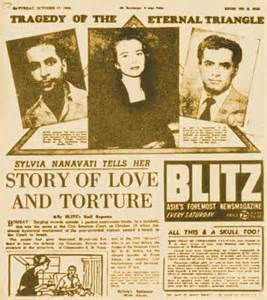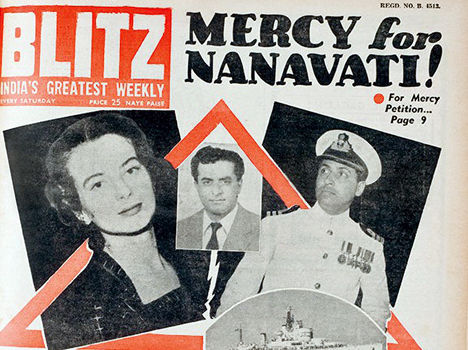State vs Nanavati- Story behind three gunshots.
- Nayan Talwar
- Jul 16, 2020
- 5 min read

Every once in a while there comes a case before Indian judiciary which triggers the change in the legal system, challenges the status-quo set by the Courts and set an example for judiciary to follow. So kick starting this Landmark and Controversial Cases in Indian Legal History series with one of those old cases which left its mark in history of Indian judiciary. It was the case which led to the end of Jury system in India in 1959. It is the same case which many of us saw in the movie- Rustom. But the movie told only a half story; today I will try to give you all a clear picture of what was this case actually about. The case was of Naval Officer Kawas Manekshaw Nanavati vs the State of Bombay.
Background of the case:
The story behind this case was as interesting as the case itself. Kawas Manekshaw Nanavati was a naval officer in the Indian Navy living in Bombay along with his English-born wife Sylvia Nanavati and children’s. As he was a naval commander, he was always away on his assignment which made Sylvia to fall for one of Kawas’s friend, Prem Ahuja, and start an affair with him. Prem Ahuja’s sister Mamie Ahuja knew about this affair. Sylvia was adamant to divorce Kawas and marry Prem but Prem was not willing to marry her.

On November 1st, 1959, Nanavati returned from one of his assignments. Sylvia was distant with him and when asked by him, she confessed having affair with Prem Ahuja. Nanavati then took his family out to the metro cinema for the show he promised and excused himself. He went to his naval base, fulfilled his obligations, and took his pistol from the official armory. He then went to Prem’s office and not finding him there, he went to his home. When he met Prem at the latter’s house, he asked him whether he is willing to marry Sylvia and accept his children. When Prem replied that he doesn’t marry every woman he sleeps with, there was a verbal confrontation between Kawas and Prem in which Nanavati fired three bullets and killed Prem. Kawas Nanavati then surrendered himself before then Deputy Commissioner of Police.
Effect of this incident:
When Kawas Nanavati was arrested, there was rising tension between the Parsi and Sindhi community which took the face of mini communal war in Bombay in 1959. Blitz magazine’s owner, who was a Parsi himself, covered every aspect of this which made Blitz very famous in 1959.

The case came before the Trial court and it was divided between the Prosecution version of story and Defence story. The Prosecution was led by one of the most prominent lawyers in the history of Indian Legal System- Shri Ram Jethmalani. While the person who defended Nanavati was a person with equal caliber- Shri Karl Khandalavala.
The Trial:
Kawas Nanavati when bought before the court pleaded not guilty and prayed that trial be taken place. The question raised in the trial was whether Nanavati shot Prem Ahuja in the heat of moment or was it planned murder. This question was raised so as to decide the quantum of the sentence because if Nanavati shot Prem Ahuja in heat of the moment, he could have invoked Exception 1 and 4 of Section 300 of Indian Penal Code which deals with Culpable Homicide amounting to murder.
Exception-1 states that “Culpable Homicide is not murder if the offender, whilst deprived of the power of self-control by grave and sudden provocation, causes the death of the person who gave such provocation or any other person by mistake or accident.
Exception-4 states that “Culpable homicide is not murder if it is committed without premeditation in a sudden fight and in the heat of passion upon a sudden quarrel and without the offender having taken undue advantage or acted in a cruel or unusual manner.
If it was believed that Ahuja’s murder was planned and it was proved then Nanavati could have been punished under Section 302 for Murder.
As every story has two sides, this case also had two versions- One by defence and another by the prosecution.
Defence’s version of story:
The defence had no witnesses to back their story, but they were certain that it was not a planned murder. They argued that when Nanavati found out about the affair, he wanted to shoot himself but he was told by Sylvia that it is not necessary and that calmed him down. Kawas with an intention to find whether Prem really loved Sylvia and is willing to marry her went to meet him. When he met Prem, he was in his bath towels. Kawas asked whether Prem intended to marry Sylvia and accept his children to which Prem replied “Will I marry every woman I sleep with?”. This enraged Nanavati who then removed the gun from his brown packet. Seeing the gun, Prem also went after the gun and in the scuffle, Prem accidentally shot himself. However, the prosecution led by Mr.Ram Jethmalani contended that it was planned murder.

Prosecution version of story:
The Prosecution accused Nanavati of the planned murder of Prem Ahuja. The first point was that according to defence Ahuja was in his towel and there was a scuffle between Nanavati and Ahuja. This created doubt that how the towel was intact in that scuffle. The second point that was raised by the Prosecution was that when Nanavati dropped his family for cinema, according to Sylvia’s statement, he was very calm and there was no anger. Nanavati went to his naval base and acquired his gun under false pretext. This showed there was no provocation and it was clearly a planned murder. The entire act took place within one minute of Nanavati reaching Ahuja residence which also rules out scuffle. So after shooting Ahuja, Nanavati surrendered himself to police who clearly showed that he knew what he did and that he was within his right frame of mind when he shot Prem.
The verdict of trial court:
The Jury after hearing both the sides, by the verdict of 7-1 pronounced Kawas Nanavati non-guilty for the murder of Prem Ahuja. According to records on the case, some accused that Jury’s decision was widely affected by public sentiments, media coverage that made Nanavati an honest officer and portrayed Prem Ahuja as a womanizer who uses women. Whatever the reason might be, the trial court acquitted Nanavati of all charges. But the decision was appealed in Bombay High Court.
Hearing in Bombay High Court:
The same points were argued from both the sides in High court as well. But here the decision was reversed by High Court. High Court was of opinion that it was indeed a planned murder and not grave and sudden provocation. High Court convicted Kawas Nanavati for Culpable homicide amounting to murder and sentenced him to Life Imprisonment. On 24th November 1961, Supreme Court upheld the decision of High Court.

Nanavati spent 3 years in prison and was released after Prem Ahuja’s sister Mamie Ahuja pardoned his prison time.
Legacy of this case:
Apart from being the last case to consist of Jury, this case was also remembered as a landmark case because of the definition of the grave and sudden provocation cleared by the court. Grave and sudden provocation need not be immediate; it can be remote as well. This case indeed was one of its kinds to go down in the history of the Indian Legal system as a head start of the process of change that took place in the Judicial system for decades to come.
Do give me your thoughts about the case. Till then stay safe, stay healthy.OM SHANTI
_edited.jpg)



Comments